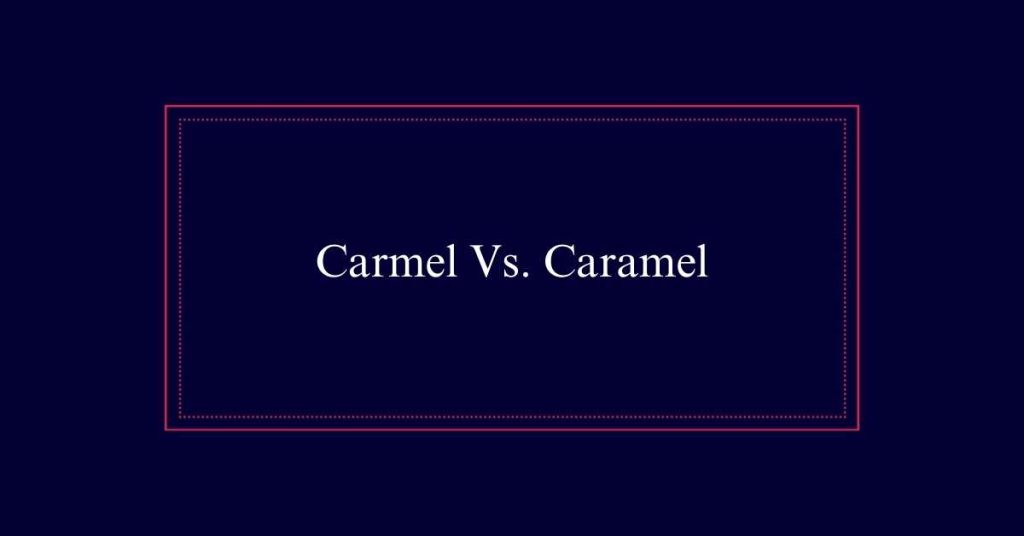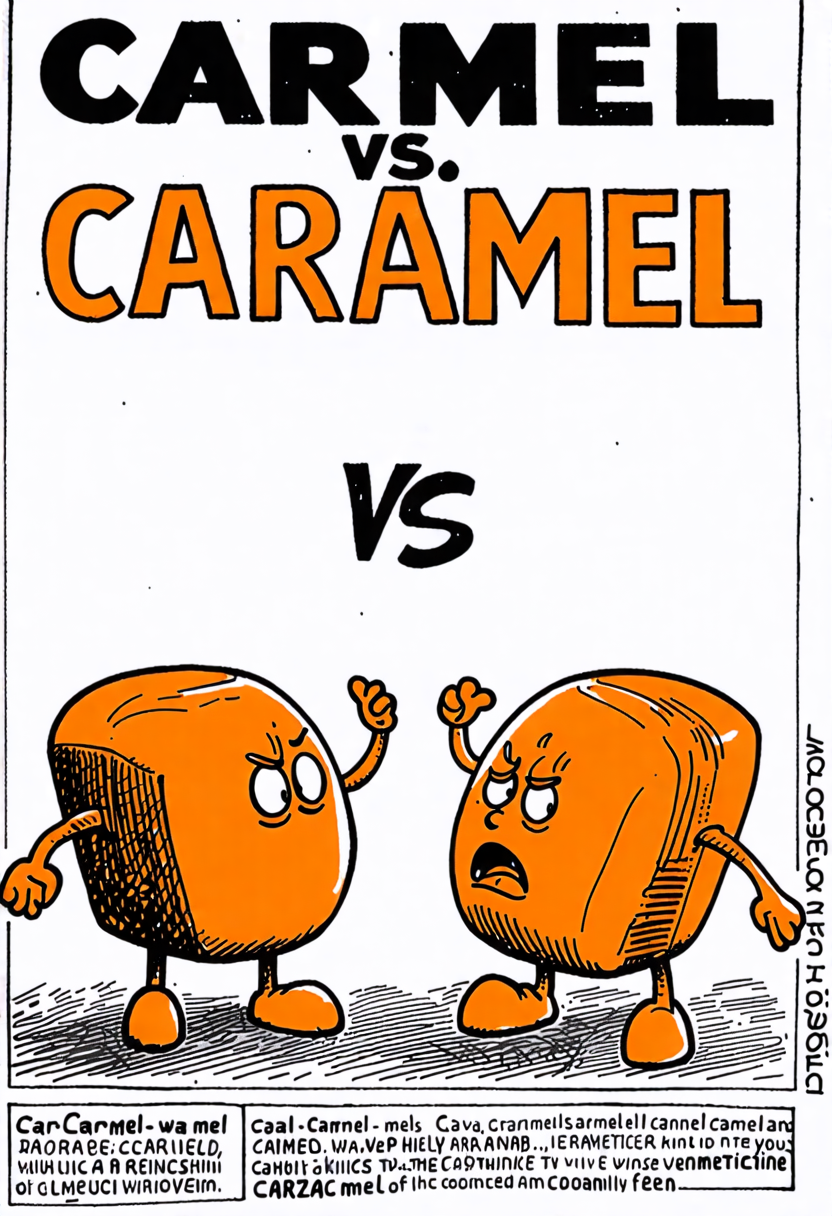Carmel Vs. Caramel
‘Caramel’ refers to a sweet substance made by heating sugar, commonly used in cooking to enhance various dishes. It appears in forms like sauces or candies and is recognized by its light brown hue. ‘Carmel,’ on the other hand, is a proper noun typically used for place names, such as Carmel-by-the-Sea in California, or as a personal name. It is not a variant of ‘caramel’ and should not be used in culinary contexts.
What Is Caramel?
Caramel is a sweet substance created by heating sugar until it turns brown. This process, known as caramelization, transforms the sugar into a rich, flavorful ingredient.
Caramel can be used in various forms, from a liquid sauce to a firm candy. It is not just a flavor but also a color, often described as a light brown hue. The substance can be made by melting sugar alone or with additions like butter to create a soft toffee.
In cooking, the verb ‘caramelize’ describes the act of heating sugar to this state. The word ‘caramel’ has been in use since the 18th century, originating from Spanish and French languages.
Caramel in Cooking
In culinary applications, this versatile ingredient enhances both sweet and savory dishes. Caramel’s rich flavor and golden hue add depth to many recipes. It can be used in various forms, from sauces to candies.
Here are three popular uses:
- Desserts: Caramel is a key ingredient in flan, crème brûlée, and caramel apples.
- Sauces: Caramel sauce is perfect for drizzling over ice cream, pancakes, or waffles.
- Savory Dishes: It can also be used in glazes for meats, adding a unique sweet-savory balance.
Caramel Spelling Variations
There are different ways to spell ‘caramelize’ depending on the region. In American English, the standard spelling is ‘caramelize’. However, in British English, it is often spelled ‘caramelise’ with an ‘s’. These variations are common and reflect regional spelling conventions.
Here are three key points to remember about the spelling variations:
- American English: ‘Caramelize’ with a ‘z’.
- British English: ‘Caramelise’ with an ‘s’.
- Consistency: Always follow the spelling norms of your region or audience.

Carmel: Proper Noun Uses
While the spelling of ‘caramelize’ varies, ‘Carmel’ has distinct uses as a proper noun. ‘Carmel’ is often used to name geographic locations, personal names, and rivers. It is not a variant of the sweet substance ‘caramel’ but holds its own unique significance in different contexts.
Here are some examples of ‘Carmel’ as a proper noun:
| Context | Example |
|---|---|
| Geographic | Carmel-by-the-Sea, California |
| Personal Name | Carmel Snow (editor) |
| River | Carmel River, California |
Cities Named Carmel
Several cities around the world are named Carmel, each with unique characteristics and histories. One well-known example is Carmel-by-the-Sea in California. This charming coastal town is famous for its beautiful beaches and artistic community.
Another notable city is Carmel, Indiana. It is recognized for its excellent quality of life and innovative roundabouts.
Lastly, Mount Carmel in Israel is a city with significant historical and religious relevance. It is known for its biblical connections and scenic landscapes.
Carmel as a Name
Beyond its use as a geographic name, Carmel is also a popular personal name. It is often chosen for its pleasant sound and religious significance. The name Carmel is derived from the Hebrew word ‘Karmel,’ which means ‘garden’ or ‘vineyard of God.’ It is associated with the biblical Mount Carmel in Israel.
Carmel is a name used for both boys and girls, though it is more commonly given to girls. It has a timeless appeal and is favored in various cultures. The name has been adopted by numerous notable individuals, adding to its popularity.
Caramel Vs. Carmel Usage
Understanding the usage of ‘caramel’ and ‘Carmel’ is essential to avoid common spelling errors and misinterpretations.
‘Caramel’ refers to a sweet substance made by heating sugar until it browns, a soft toffee, or a light brown color. It is also used as a verb in cooking, e.g., to caramelize sugar.
Conversely, ‘Carmel’ is a proper noun and typically refers to geographic locations or personal names. For example:
- Carmel-by-the-Sea: A beach town in California.
- Mount Carmel: A mountain range in Israel.
- Carmel River: A river in California.
Caramel’s Historical Origins
The term ‘caramel’ entered the English language in the 18th century, derived from the Spanish word ‘caramelo’ through French influences. Its introduction marked a significant addition to culinary terminology.
The transformation of sugar into a golden-brown substance had been a practice known to ancient civilizations. However, the naming conventions evolved over time, reflecting cultural and linguistic shifts.
The French influence on English during the 18th century facilitated the adoption of many culinary terms, including ‘caramel.’ This adoption was part of a broader trend of borrowing words from other languages to enrich English vocabulary.
Caramel in Everyday Language
Caramel, having established its historical roots, now permeates everyday language in numerous contexts. This versatile term is frequently used in culinary arts, fashion, and casual conversation. Here are three primary ways it appears:
- Culinary Uses: Caramel is a popular flavoring in desserts like flan, candies, and sauces. The process of caramelizing sugar is fundamental in many recipes.
- Color Description: The term ‘caramel’ denotes a rich, light brown hue. It is often used in fashion and interior design to describe a warm, inviting color.
- Metaphorical Language: In casual speech, ‘caramel’ can describe something smooth or sweet. For example, someone might refer to a ‘caramel voice’ to indicate a soothing, pleasant tone.







